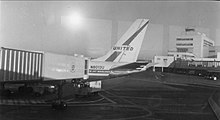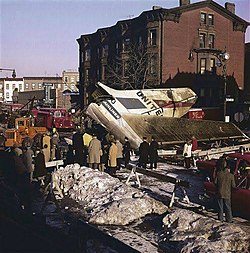|
1960 New York mid-air collision
On December 16, 1960, a United Airlines Douglas DC-8 bound for Idlewild Airport (now John F. Kennedy International Airport) in New York City collided in midair with a TWA Lockheed L-1049 Super Constellation descending toward LaGuardia Airport.[1] The Constellation crashed on Miller Field in Staten Island and the DC-8 in Park Slope, Brooklyn, killing all 128 aboard the two aircraft and six people on the ground. The accident was the world's deadliest aviation disaster at the time, and remains the deadliest accident in the history of United Airlines. (United Airlines Flight 175, with close to 1000 total deaths, is excluded as the flight crashed not by accident but due to a terrorist attack.)[2] The accident became known as the Park Slope plane crash or the Miller Field crash[3] after the two crash sites. The accident was also the first hull loss and first fatal accident involving a Douglas DC-8.[4][5] Aircraft and crews United Airlines Flight 826, Mainliner Will Rogers, registered as N8013U,[6] was a DC-8-11 carrying 77 passengers and 7 crew members from O'Hare International Airport in Chicago to Idlewild Airport in Queens. The crew consisted of Captain Robert Sawyer (age 46), First Officer Robert Fiebing (40), Flight Engineer Richard Pruitt (30) and four stewardesses.[7] Captain Sawyer was a highly experienced pilot, having accumulated 19,100 flight hours, of which 344 were in the DC-8. First Officer Fiebing had accumulated 8,400 flight hours, of which 416 were in the DC-8. Flight Engineer Pruitt had accumulated 8,500 flight hours, of which 379 were in the DC-8.[1] Trans World Airlines Flight 266, Star of Sicily, registered as N6907C,[8] was a Super Constellation carrying 39 passengers and 5 crew members from Dayton and Columbus, Ohio, to LaGuardia Airport in Queens. The crew consisted of Captain David Wollam (age 39), First Officer Dean Bowen (32), Flight Engineer LeRoy "Lee" Rosenthal (30) and two stewardesses, Margaret Gernat and Patricia Post.[9] Captain Wollam had accumulated 14,583 flight hours, 267 of which were in the Constellation. First Officer Bowen had accumulated 6,411 flight hours, of which 268 were on the Constellation. Flight Engineer Rosenthal had accumulated 3,561 flight hours, of which 204 were in the Constellation.[1][10] Star of Sicily's sister ship N6902C, Star of the Seine, was destroyed in another mid-air collision with a United Airlines flight in 1956.[11] Background At 10:21 a.m. EST, United 826 advised ARINC radio that one of its VOR receivers was inoperative, and the message was relayed to United Airlines maintenance. However, air-traffic control (ATC) was not informed that the aircraft had only one operational receiver, which presented difficulty for the pilots of flight 826 to identify the Preston intersection, beyond which it had not received clearance. At 10:25 a.m., ATC issued a revised clearance for the flight to shorten its route to the Preston holding point (near Laurence Harbor, New Jersey) by 12 miles (19 km). That clearance included holding instructions (a standard "racetrack" holding pattern) for Flight 826 when it arrived at the Preston intersection. Flight 826 was expected to reduce its speed before reaching Preston to a standard holding speed of 210 knots (240 mph; 390 km/h) or lower. However, the aircraft was estimated to be traveling at 301 knots (346 mph; 557 km/h) when it collided with the TWA plane, several miles beyond the Preston clearance limit. During the investigation, United Airlines claimed that the Colts Neck VOR was unreliable.[12] Preston was the point where airway V123—the 050-radial off the Robbinsville VOR—crossed the Solberg 120-degree radial and the Colts Neck 346-degree radial. However, the Civil Aeronautics Board's final report found no problem with the Colts Neck VOR. The prevailing conditions were light rain and fog, which had been preceded by snowfall. Collision and ground impacts According to the DC-8's flight data recorder, the aircraft was 12 miles (19 km) off course, and for 81 seconds it descended at 3,600 feet per minute (18 m/s) while slowing from more than 400 knots (460 mph; 740 km/h) to 301 knots (346 mph; 557 km/h) at the time of the collision. One of the DC-8's starboard engines struck the Constellation just ahead of its wings, tearing apart a portion of the fuselage. The Constellation entered a dive, with debris continuing to fall as it disintegrated during its spiral to the ground. The initial impact tore the DC-8's engine from its pylon. Having lost one engine and a large part of the right wing, the DC-8 remained airborne for another 90 seconds. The DC-8 crashed into the Park Slope section of Brooklyn at the intersection of Seventh Avenue and Sterling Place (40°40′38″N 73°58′25″W / 40.67709°N 73.97368°W), scattering wreckage and setting fire to ten brownstone apartment buildings, the Pillar of Fire Church, the McCaddin Funeral Home, a Chinese laundry and a delicatessen. Six people on the ground were killed.[13][1] The crash left the remains of the DC-8 pointing southeast toward a large open field at Prospect Park, blocks from its crash site. An occupant in one of the affected apartment buildings said that his family survived because they were in the only room of their apartment that was not destroyed. The crash left a trench covering most of the length of the middle of Sterling Place. Witnesses thought that a bomb had detonated or that a building's boiler had exploded. The TWA plane crashed onto the northwest corner of Miller Field at 40°34′12″N 74°06′11″W / 40.57°N 74.103°W, with some sections of the aircraft landing in New York Harbor. At least one passenger fell into a tree before the wreckage hit the ground.[12][1] There was no radio contact with traffic controllers from either plane after the collision, although LaGuardia had begun tracking an incoming, fast-moving, unidentified plane from Preston toward the LaGuardia "Flatbush" outer marker.[14] Investigation The likely cause of the accident was identified in a report by the US Civil Aeronautics Board:
The report notes "various steps to improve and strengthen the efficiency and effectiveness of its Air Traffic Control System" based on the crash investigation. Listed steps include better reporting of malfunctioning communications/navigation equipment, retrofitting airplanes with distance measuring equipment, improved handoff techniques for air traffic control, and additional speed rules when approaching a destination airport.[1] VictimsThe only person to initially survive the crash was Stephen Baltz, an 11-year-old boy from Wilmette, Illinois. He was traveling unaccompanied on Flight 826 to spend Christmas in Yonkers with relatives. He was thrown from the plane into a snowbank, where his burning clothing was extinguished. Although alive and conscious, he was severely burned and had inhaled burning fuel.[13] Baltz died of pneumonia the next day.[15] Other notable victims included chemist Jonas Kamlet, who was on Flight 826,[16] and Garry and Caroline Myers, the founders of the children's magazine Highlights, both of whom were on Flight 266.[17] Mountaineer Edmund Hillary, known for being one of the first two people to reach the summit of Mount Everest, was also booked onto Flight 826 but arrived too late to board.[18] LegacyThe total of 134 victims would not be surpassed until a Lockheed C-130B Hercules was shot down in May 1968, killing 155 people.[19] In terms of commercial aviation, the death toll would not be surpassed until the March 1969 crash of Viasa Flight 742, which crashed on takeoff and killed all 84 people on board the aircraft, as well as 71 people on the ground.[20] In 2010, on the 50th anniversary of the accident, a memorial to the 134 victims of the two crashes was unveiled in Green-Wood Cemetery, Brooklyn. The cemetery is the site of the common grave containing the remains of those who could not be identified.[21][22] The collision is covered in "Collision Course", the fifth episode of the first season of The Weather Channel documentary series Why Planes Crash.[23] The collision figures prominently in Episode 3, Season 5 of the Amazon television series The Marvelous Mrs. Maisel. The collision is a plot point in Kristin Harmel's book The Paris Daughter. The collision is featured in the novella If It Bleeds by Stephen King, which was published in 2020 in the anthology of the same name. See also
References
External links
|
||||||||||||||||||||||||||||||||||||||||||||||||||||||||||||||||||||||||||||||||||||



